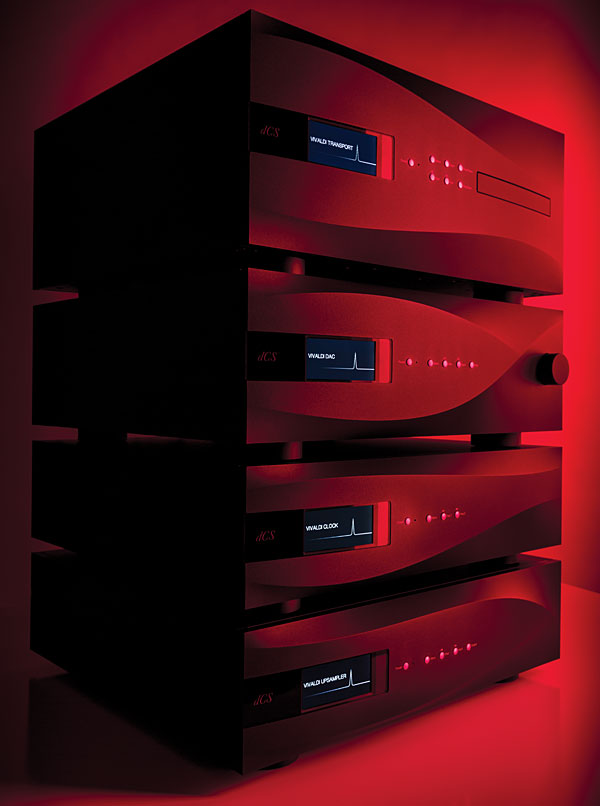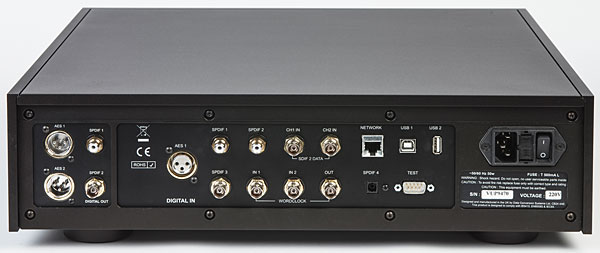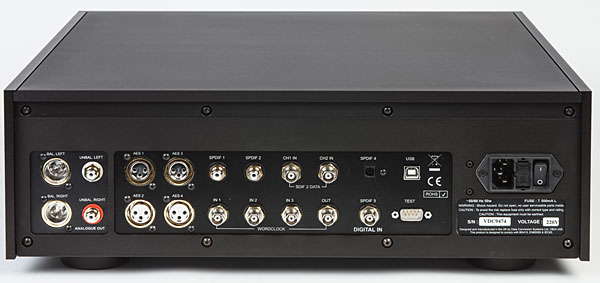Download
Popular Posts
-
Gibboni and the Gibbon: At Stereo Exchange’s annual Spring High-End Audio Show, Roger Gibboni (left) of Rogers High Fidelity debu...
-
Hey, we were in earthquake country, the land from which Carole King may have received inspiration to write, "I Feel the Earth Move...
-
A reader once noted that I tend to stick with the same reference gear longer than most reviewers. In addition to Audience's Au24e i...
-
The Enigmacoustics company from Irvine in California has become renowned for the self-energized, horn-loaded Sopranino electrostatic su...
-
Today, Sony announced an end to production on all MiniDisc players. In a few years, MiniDisc production will cease as well. I know w...
-
The name sounds perfect . It fits neatly next to those of Messrs. Leak, Sugden, Walker , Grant, Lumley, and others of Britain's...
-
Silicon Valley–based Velodyne was founded in 1983 to develop a range of subwoofers that used servo-control to reduce non-linear distorti...
-
I've heard a lot of great audio components over the years, but even in that steady stream of excellence, a few have stood out as so...
-
I've long kept an eye on Michael Creek's loudspeakers (Epos) and electronics (Creek). He's always moving forward, with eith...
-
You don't need me to tell you that listening habits are changing. Although those who predict that the end of our beloved home stere...
Market information
Blog Archive
-
▼
2014
(109)
-
▼
January
(87)
- AURALiC VEGA D/A processor
- Matt Wilson's Gathering Call
- Epos Elan 10 loudspeaker
- The Entry Level #38
- As We Listen, So We Are
- Recording of the Month: Classified: Remixed and Ex...
- Digital Demo at Coup de Foudre
- Mary Halvorson’s Illusionary Sea
- What to Make of CES 2014 and Beyond?
- JA’s Best Sound at CES: Vandersteen’s Model 7 Spea...
- Naim’s Statement Amplifier
- Wilson’s New Sasha
- Vivid’s new Giya G4
- Pass Labs Pays Tribute to Sony
- Magico's New S3
- The Ultimate Magico
- DartZeel's Integrated Streaming Amplifier
- Meridian’s Bob Stuart & 25 Years of Digital Loudsp...
- YG’s Hailey
- Marten’s Coltrane Supreme 2
- GoldenEars’ New Triton 1
- Enigma Introduces Complete Speaker
- Warmth from Zesto
- MAD as Hell?
- Handsome Klangwerk from Switzerland
- Cary Audio DMS-500 Digital Music Streamer
- Prismatic Sound from Joseph Audio
- Vienna Acoustics’ Imperial Series Liszt
- Eclipse Back in the USA
- The Canalis Amerigo speaker
- MartinLogan’s Motion Series Speakers
- Krell's new iBias Amps
- PrimaLuna's forthcoming Dialogue Premium HP
- Creek EVO 50CD Player/DAC
- Resolution Audio
- Arcam’s FMJ A49 Mega integrated amplifier
- ADAM’s Tensor Beta Mk.II
- The Tannoy Kingdom Royal Carbon Black Edition
- The Usher Grand Tower
- Rosso Fiorentino, Graaf, and More
- Graaf, Rosso Fiorentino, and More
- Dan D'Agostino Master Audio Systems' Eye Candy
- Dynaudio Updates Excite Series
- Dynaudio Drops XEO Prices
- Genesis Muse Music Source (G-Source)
- Bel Canto Black ASC1 Preamp/DAC
- Project DAC BOX RS
- The Heart of Manley Labs
- Audio Arts & Zellaton's Reference loudspeakers
- ATC & Antelope
- Angelic Sound
- One touch—the BeoSound Essence
- Astell&Kern Branches Out
- Bam Bam from Tyr-Art
- VAC's Soon-to-Emerge Preamp
- Nagra HD DAC
- MBL Revamps its Noble Line
- Cozying up with Rogue's Egyptian Royalty
- BAT's Big Change
- Constellation Comes Nearer to You
- The New 6T from Aerial Acoustics
- BSG's øReveel
- New from Epos at the 2014 CES
- Light Harmonic, LH Labs, & Indiegogo
- On The Left: PCM
- On The Right: DSD
- Weiss DAC202 DSD Update
- Macintosh MB100 Media Bridge
- The Nicolls
- Peachtree's Sweet Nova
- Flying by Moon with Simaudio
- LA Audio . . . from Taiwan
- Stereophile's Products of 2103
- New DSD DACs from Korg
- PSB's Desk-Top Subwoofer
- Chord Hugo DAC/Headphone Amp
- Inside Llewyn Davis
- Esoteric Grandioso D1 Monoblock DAC
- Aesthetix Romulus and Pandora Signature Upgrades
- Accuphase DP-720 SACD/CD Player
- Olasonic Nano Campo Line
- Arcam miniBlink Bluetooth Streaming DAC
- Antelope Rubicon Atomic AD/DA Preamp Appears
- Light Harmonic Sire DAC
- dCS Vivaldi digital playback system
- Old and New: A 2014 Resolution
- The Ultimate Headphone Guide: Now Available for Pu...
-
▼
January
(87)
dCS Vivaldi digital playback system

The Scarlattis improved on the Elgar Pluses in cosmetics and, more important, technical and sonic performance that, in the opinion of many, put it at the top of the digital audio heap. It will be obvious to those familiar with the Scarlatti stack that the Vivaldis take visual appearance and fit'n'finish to new heights. These sculpted boxes in a silver matte finish, each with a unique, flowing wave pattern machined into its front panel, are pleasing to the eye and silky-smooth to the touch. Who said engineering geeks aren't sensual?
The four components are: the Vivaldi DAC ($34,999, slightly more than the original Elgar-Purcell-Verdi combo), which, using can decode every digital resolution, from MP3 to DSD to DXD (a 24-bit/358.8kHz PCM format used primarily for editing DSD files) and everything in between; the Vivaldi Upsampler ($19,999), which can upconvert the lowest-resolution MP3 data to 24/384, DSD, and DXD or any format in between; the Vivaldi Master Clock ($13,499), containing two groups of four clock outputs, which can be independently set; and the Vivaldi Transport ($39,999), a smooth, quiet, quick-booting SACD/CD drive based on TEAC's Esoteric VRDS Neo disc mechanism, considered by many to be the world's finest (footnote 1). This is controlled by dCS-designed signal-processing electronics, and can also upsample CDs to DSD or DXD.
The total price is an astronomical $108,496, though of course you could start with just the DAC and save $73,497. Considering the cost of some preamplifiers, audiophiles with only a single source component can drive their power amplifier directly with the Vivaldi DAC, which has a digital-domain volume control, and save the cost of a standalone preamp.

Most audiophiles prepared to drop $35k on a DAC will head straight for the full stack, I feel, especially those who want to add a music server, since the Upsampler includes an Ethernet connection for network streaming via UPnP. (dCS makes available a free iPad app to work with UPnP-based servers.) While both the DAC and the Upsampler have an asynchronous USB-B port, to allow them to accept audio data from a computer, the Upsampler also has a USB-A port, for use with USB flash drives or i-Devices. The USB-B ports can operate in Type 1 mode, with data sampled up to 96kHz, or in Type 2 mode, which allows DSD and PCM up to 192kHz to be streamed to the Vivaldis. Type 1 operation doesn't require a driver program for Windows PCs or Macs; Type 2 operation doesn't need a driver with Mac OS10.6.3 or later; dCS supplies a driver program for Type2 operation with Windows XP and Windows 7. (They say that it will work with Windows 8 in Windows 7 compatibility mode.) The dCS driver is not compatible with ASIO-type drivers, which will need to be uninstalled.
In other words, while continuing to offer a transport option for those with large collections of CDs and SACDs, dCS has configured the Vivaldi for the discless future—already the present for some, particularly those who never got into SACDs—though it will still be some time before downloadable DSD content catches up with what's already available on disc.
Major Changes Inside
Compared with the older products, the structural rigidity of the Vivaldi components' cases has been upgraded, including top plates of thick aluminum into which are machined asymmetrical cavities that contain damping pads. The combination is said to reduce vibrational modes. But the Vivaldi DAC's insides have been given far more than a cosmetic makeover.
While dCS's products have all been based on the company's proprietary Ring DAC technology, the Vivaldi is based on a complete revision of the Ring DAC concept. The earlier Ring DAC used quad latches (a circuit element that can be instantaneously "flipped" between two stable states) to select current sources based on metal-film resistors. The new Ring DAC design still includes high-speed latches and metal-film resistors, but instead uses individual latch chips said to eliminate between-latch, on-chip crosstalk resulting in lower jitter. The total number of latches has been increased to make better use of the Ring DAC's available dynamic range. A pair of high-speed, software-updatable (FPGAs) replaces the Scarlatti's mapping ROM chips, which allows individual errors in the DAC's current sources to be randomized, reducing the level of distortion and spuriae by 3dB.
The Vivaldi DAC's and Upsampler's digital-processing platform, which runs dCS-developed and -maintained code that forms the core of the entire operating system, has been completely upgraded, including use of a single field-programmable gate array (FPGA) chip with more than twice the capacity of the previous two chips combined. These FPGAs are programmed from flash memory each time the DAC powers up, so that performance improvements or new Ring DAC operating modes can be added with a firmware update.

The Vivaldi DAC's analog circuitry has been redesigned for reduced DC offset, lower noise, and less crosstalk. The completely dual-mono architecture is claimed to improve left/right crosstalk by 15dB at 20kHz. New, higher-output mains transformers in all of the Vivaldi components run cooler than in earlier dCS products, and are mounted on specially damped subchassis to eliminate vibrations. Even the transport has been given a serious mechanical upgrade, which is claimed to reduce the level of acoustic noise by a significant 10dB.
The Vivaldi stack's exterior elegance sacrifices some user-friendliness: the small buttons and their even smaller labels aren't backlit, so if you like doing your digital business in the dark, or even in moderate light, keep a flashlight handy.
The non-backlit remote control suffers a similar problem. While it's a heavy, nicely made piece of aluminum finished pleasingly for the hand, its brushed-aluminum surface makes it difficult to read the labels just below the unmarked buttons unless it's angled just so to reflect any available light. But when you do that, the reflected glare makes the buttons that are marked hard to read.
Setup and Use
Setting up the Vivaldi system can be complicated, but when you spend almost $110,000 on a digital playback system, you can expect plenty of dealer help. The multi-cable system, featuring five AES/EBU cables—two each to connect the Transport and Upsampler to the DAC and a fifth to connect the Transport to the Upsampler—five word-clock connections, and four AC cords, is a cable manufacturer's dream.
But once everything has been set up for you, and the routing for each input and the many screen icons have been explained, you're on your own. Believe me, until you figure it all out and memorize the icons' meanings, you'll feel lonely.
Your options are then seemingly endless. For example, you can route the transport directly to the DAC via the dual AES/EBU connections, which will send DSD signals in their native format and, should you choose, upsample CDs to DSD or DXD—or you can send CD signals to the DAC via S/PDIF or AES/EBU and play them in their native resolution—or send CD data to the Upsampler via the single AES/EBU connection and, by selecting the Upsampler's AES input, play them back at 24/44.1 (the Upsampler automatically outputs at 24 bits)— or you can upsample the CD data there to high-resolution PCM or DSD.
The Vivaldi DAC has six filter options for PCM, with four more for DSD playback. dCS says that with PCM data, the first four filters give different tradeoffs between ultrasonic image rejection and impulse response. Filter 1 gives the most rejection, Filters 2–4 offer progressively relaxed image rejection and better time-domain performance. For data with sample rates from 176.4kHz to 384kHz, two extra filters are available, one with a Gaussian character, the other asymmetrical with almost no pre-ringing. With CD data, Filter 5 is also an asymmetrical type, Filter 6 a very sharp linear-phase type with pre-ringing. The DSD filters progressively roll off the format's ultrasonic noise, in case there are system synergy issues.
dCS recommends Filter 5for CD playback, Filter 2 for 48, 88.2, and 96kHz-sampled data, Filter 6 for 176.4kHz data and above, and Filter 1 for DSD data. For this review, I stuck with Filter 1, which had been recommended by dCS distributor John Quick.
Footnote 1: Why should a disc drive be so expensive? dCS claims that they pay about $5000 for each raw TEAC transport; if you do the usual fivefold "parts cost to retail" math, that's $25,000—then you have to add the chassis, the electronics, and the rest.
| | |||||||||||||
Source : stereophile[dot]com

- Không có bài viết liên quan

Comments[ 0 ]
Post a Comment